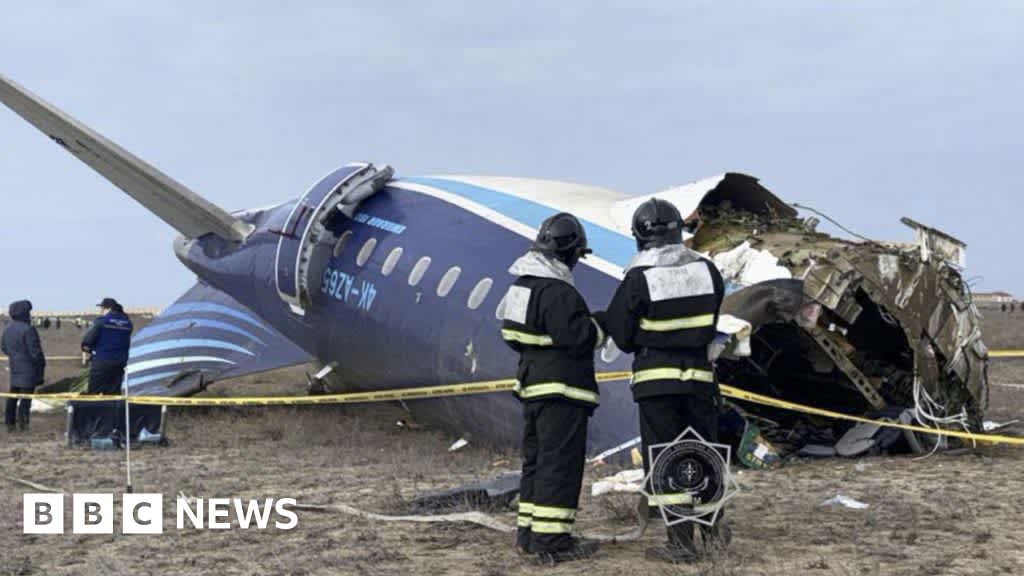On 25 December, 38 people died when an Azerbaijan Airlines flight, which had been due to land in Russia, crash-landed in Kazakhstan.
The circumstances around the crash remain unclear, but limited evidence so far suggests it may have been damaged by missiles fired by a Russian air-defence system as it tried to land in Chechnya.
Here’s what we know about Flight J2-8243.
In the early morning on Christmas Day, Flight J2-8243 took off from the airport of Baku, the capital of Azerbaijan. It was due to land in Grozny, the capital of the Russian region of Chechnya.
On board were 67 passengers, most of whom were Azerbaijani nationals, as well as those from Russia, Kazakhstan and Kyrgyzstan.
The plane was an Embraer 190, operated by Azerbaijan Airlines.
As the flight approached Grozny, it entered thick fog, surviving passengers say.
They describe the pilot attempting to land the plane twice during these conditions.
It was on the third attempt, survivors say, that they felt a series of explosions hit the plane.
“The third time, something exploded… some of the aircraft’s skin had blown out,” one told Russian TV.
A flight attendant on the plane, Zulfuqar Asadov, told local media the impact of the strike “caused panic inside”.
“We tried to calm [the passengers] down, to get them seated. At that moment, there was another strike, and my arm was injured,” he said.
A video filmed in flight by a passenger showed oxygen masks hanging from the ceiling.
Azerbaijan’s transport minister Rashad Nabiyev said: “All [the survivors] without exception stated they heard three blast sounds when the aircraft was above Grozny.”
He said the plane was subjected to “external interference” and damaged inside and out as it tried to land.
In recent weeks, Ukraine has been targeting Chechnya and other parts of the Russian Caucasus with drone strikes.
After the crash, authorities in Moscow said such attacks had triggered a protocol to close the airspace above Grozny.
According to local officials, a drone was shot down by air defence above a shopping mall in Vladikavkaz, in nearby North Ossetia, that morning.
It is unclear whether the closed-airspace protocol – known as a “carpet plan” – was enacted before or while Flight J2-8243 was in Russian air space.
After the incident over Grozny, the plane diverted some 450km (280 miles) east to Aktau airport in Kazakhstan.
It remains unclear why it was diverted over the Caspian Sea – a far longer journey than several other options.
Russian aviation authorities have claimed the pilots of the plane were “offered other airports”, but chose Aktau.
Data released by the flight-tracking website Flight Radar shows the plane zig-zagging up and down as it approached Aktau, before turning and crash-landing just kilometres from the airport.
Video from near the scene shows the plane descending rapidly through the air before crashing into the ground and skidding for several hundred metres in a ball of flame.
38 people were killed and 29 survived, some with serious injuries. Remarkably, some survivors were seen walking and crawling from the plane’s wreckage.
It is believed most of those who survived were seated in its rear.
Initial reports from Russian media suggested the aircraft collided with a flock of birds.
However, aviation experts and others in Azerbaijan believe the plane’s GPS systems were affected by electronic jamming and it was then damaged by shrapnel from Russian air-defence missile blasts.
On Friday White House national security spokesperson John Kirby told reporters that the US had “early indications” Russia was responsible, but declined to comment further.
So far, Azerbaijan’s government has avoided directly accusing Russia – but Azerbaijani government sources told Reuters news agency that the investigation has already identified the weapon that fired on the flight as the Russian Pantsir-S anti-aircraft system.
The Kremlin has so far refused to comment on reports the plane was hit by Russian weaponry.
“An investigation… is under way and until the conclusions are made as a result of the investigation, we do not consider ourselves entitled to give any assessments,” said spokesman Dmitry Peskov.
The plane’s flight recorders, which contains data to help determine the cause of a crash, had been found.
Reports in Baku suggest both Russia and Kazakhstan have proposed having a committee from the Commonwealth of Independent States (CIS) – a regional organisation dominated by Russia – investigate the crash, but Azerbaijan has instead demanded an international inquiry.
Azerbaijan Airlines and several other airlines have suspended flights to some Russian cities in response to the crash.
Source: www.bbc.com
